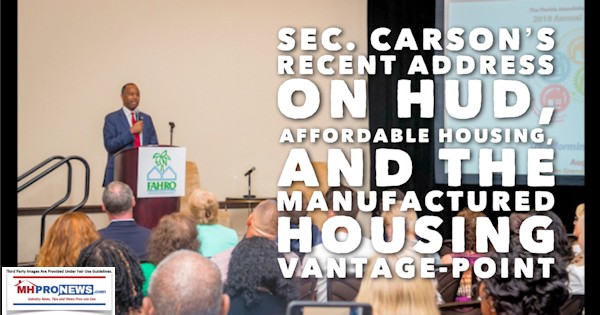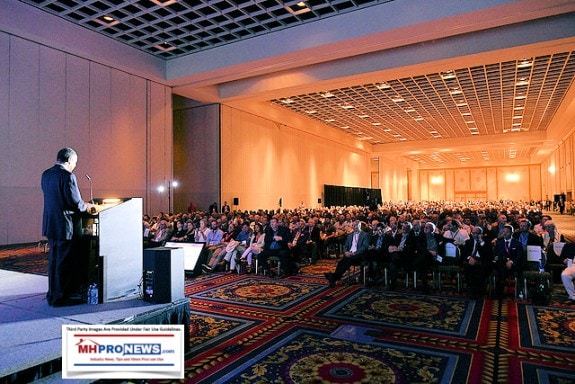
By contrast, Mark Weiss, in a soon-to-be-released commentary, told MHProNews that “HUD Secretary, Dr. Ben Carson, as the saying goes, “gets it.”
First, and most fundamentally, he understands – and has very plainly stated — that to successfully address and ultimately solve the nation’s affordable housing crisis, which has some 21 million American families spending more than one-third of their household income on housing expenses and 11 million of those spending more than half of their income on housing, it is “vitally important … to develop more affordable housing.”

Perhaps the best ‘get’ of the year for MHI are the comments that Secretary Carson made to their last Congress and Expo scheduled in Las Vegas. There, per HUD’s official transcript to MHProNews, Dr. Carson said:
“When I originally got the invitation to join you [manufactured housing professionals], “I was quick to say yes. Back when my hair was less gray, when you thought of manufactured homes, you basically thought of a small box, on concrete blocks, with some uninspiring siding or trim. Times have certainly changed.”
It’s a theme that many cited by MHLivingNews or MHProNews have shared.
“Let me say straight out, at HUD, it is not about how much money we spread around. We define success not by the amount of money we pour into our programs, but by the number of people we help graduate from our services and become self-sufficient. Only then can we begin to help others in need of our resources.” said Carson, per HUD.
Carson said that at HUD, “we drive for new efficiencies, transparency, and accountability in our large portfolio – or as some would call it, our alphabet soup of programs and services.”
“That’s why everyone in this audience and the manufactured housing industry is so important – and that’s why I am here today. You are a big part of the solution to providing unsubsidized, quality, affordable housing.”
That’s a snapshot of why MHARR’s president’s case for Secretary Carson ‘getting it,’ about manufactured housing is hopeful.
HUD and Transparency
Needless to say, there are a variety of audiences that Dr. Carson addresses.
One doesn’t expect Secretary Carson to say the same things, or stress the same points. But are the broad-brush principles he espouses in synch?
Tonight, against that backdrop, we’ll feature a release from HUD on Sec. Carson’s address to a group in Orlando 2 days ago.

HUD Secretary Ben Carson Delivers Remarks at the
Florida Association of Housing & Redevelopment Officials (FAHRO) Annual Convention
Orlando, FL ~ August 6, 2018
Thank you all for the invitation.
Also, I would like to thank Debbie Johnson, the current President of FAHRO, and William Russell, President and CEO of the Sarasota Housing Authority.
I really appreciate the testimony William gave on behalf of FAHRO, in late April, before the Subcommittee on Housing and Insurance on rent reform. As you’ll hear in a few minutes, we are aligned on all the major issues.
When I got the invitation, I knew I had come to your convention and expo and discover what new programs and policies are in the works for Florida’s 84 housing authorities.
As the local Sarasota Herald-Tribune mentioned in a recent editorial, there is a lot the Secretary of HUD could learn from what Housing officials are doing in Florida, so here I am.
Sarasota Visit
I ought to also mention that I was in Miami just last week – to announce an end to veteran homelessness in Miami-Dade County – and before that, I was in Sarasota with William, handing out free books to children living in public housing as part of HUD’s Book-Rich Environments Initiative. This is a win-win partnership with the National Book Foundation, our public housing authorities, libraries, educational partners, and everyone involved.
I think the children were more excited about the books they were receiving than the ice cream that was also being handed out. That’s a wonderful observation.
Growing up in Detroit, I learned that between the covers of those books we could go anywhere, we could do anything, we could be anyone – books can help you believe in yourself, and with that vision, you can accomplish most anything.
That’s why we are here today, to have a conversation and ultimately move forward on new initiatives to help our residents have a vision of themselves living a life full of many possibilities outside of public housing and realizing their God-given potential.
The question is, how do we accomplish this? And that’s mainly what I would like to discuss with you today – the key goals of our “Making Affordable Housing Work” rent reform proposal, and how it dovetails with FARHO’s action plan on reform.
Rent Reform: Making Common Cause
It’s no secret that the current rent system is counterproductive. I understand your discouragement and frustration. Every one of us here knows that the current model of public housing is unsustainable, in both dollars and common sense.
Let’s look at three main concerns we both share.
First, the rent system, as it currently exists, perpetuates an economic disincentive to earn more in wages.
Our policies ensure that the more our residents earn, the more rent they have to pay. Where then, is the incentive to work, or to get a better paying job, or have two parents living together and sharing their wages? There isn’t any, I’m afraid to say.
The unintended consequences of the way we calculate the level of assistance – more specifically, how it can hold back the very people we’re supposed to help – must be the central piece of any reform efforts.
Second, it is common knowledge that the current system is unduly difficult.
Is there a tenant, housing authority or policy maker who hasn’t been puzzled by the complexity of our rental model? Or, extremely troubled by the resources in time and staff, you must allocate to carry out the necessary procedures?
We all know how dense and complicated the system is: public housing agencies, owners, and residents must monitor and record more than several dozen different sources of income – from figuring out future incomes and tax deductions, to recording detailed medical, child, and other mandated information.
It creates a perfect storm of paperwork that is incredibly burdensome and often creates confusion along with errors. We have discovered that each year, nearly 25 percent of rents charged to HUD-assisted families are miscalculated, resulting in $750 million in improper rent payments.
So, why would we continue a policy that costs us millions of dollars in errors? Any rental reform also needs to tackle head-on this mounting burden as well.
Third, we also find common cause in changing a policy that forces all public housing authorities into a one size-fits-all system, to one that grants greater flexibility – so that those with “boots on the ground,” not Washington, will have increased local control and choice on how best to serve their communities and encourage residents on the road to independence.
Just look at the 39 Moving to Work demonstration programs that provides this flexibility for public housing agencies. It has proven to be so successful that the 2016 Consolidated Appropriations Act expands this program by an additional 100 public housing authorities.
The question remains then, why are we still committed to a policy that gives very little flexibility to local housing agencies that best understand the specialized needs of their residents?
We therefore need to push for policies that encourage choices and grant waivers that allow more innovation and experimentation.
Unstainable Rental System
Most of you know the large number of new applications who file for housing assistance and receive it – only one in four — and the small number who graduate out.
Overall, public housing was originally meant be help vulnerable people take their first step toward self-sufficiency, and not be an end in itself — with families locked into helplessness for generations, relying solely on the federal purse for survival. Though, in rare cases, some agencies do require time limits on staying in federal housing.
That’s why we need to make rental reform a top priority. But I would be remiss if I also didn’t mention the need to encourage more private sector investment in affordable rental units, as well as helping our able-body residents secure better job opportunities – a point I will return to later.
Up Date: Where We Go from Here
Overall, the Administration’s legislative proposal is only the first step on the road to major reform. But even today, we are having an impact on helping define the debate and drawing attention to the pressing need for a change – both in the way we calculate rent and require minimum work requirements for work-able households.
Since our original proposal to increase tenant contributions, both houses of Congress plan to continue to fund our housing assistance programs at historic funding levels, around $1.25 billion — so that decreases for now, the immediate need for any rent increases.
As to where we are, in getting our rent reforms through Congress, Representative Dennis Ross and I had a good discussion recently regarding his draft bill, which contain several of our key suggestions.
Conclusion: Moving Toward Self-sufficiency
Let me conclude on this note.
For generations, the idea of the government providing housing assistance meant only one thing—helping to pay the rent so families can have a roof over their heads. But we must think also about how we can help families access financial, education, and other opportunities.
In short, we must think beyond investing in bricks and mortar and invest in human capital. In today’s very tight labor market, employers are desperate for workers, and we need to rise to the challenge. The result being a win-win for everyone – with tenants earing more money so they can move out, and the local economy getting the manpower it needs.
That’s why HUD is focusing far more on policies and partnerships with the public and private sector and nonprofit community to further develop the skills and talents of our residents – with the end goal an independent life out of public assistance.
I know you’re familiar with Job Plus, Moving to Work, and Section 3 – in fact, we just kicked off a major conference with all the parties involved to reinvigorate the program. There is also the launch of our new EnVision Centers, located on or near our public housing developments.
We need to envision a new path forward for our residents — one takes a holistic approach and goes beyond simply providing housing – and these Centers will provide a one-stop shop, for key services in health, education, and job training.
I am certain we can all agree with this approach and ultimate goal.
By working together, we’re going to make these major changes in how our affordable housing system operates, so that it encourages economic advancement and well-being for Florida’s vulnerable families.
FAHRO and HUD make a formidable team and together we will make rent reform happen.
Thank you again for the invitation to join you in Orlando. I look forward to your questions.

— end of HUD’s official Carson transcript —

A fair reading of his statements to FAHRO, mindful of the difference in audience, does reflect a similar desire to lift people from dependence to independence.
With indications that HUD will complete their regulatory review this year of the manufactured housing program, the industry will move from reading tea leave to seeing just what happens on issues such as:
- Title I, and changing the 10-10 rule,
- Enhanced preemption being fully implemented,
- A non-career administrator being appointed,
- And the other aspects that are required by law under the Manufactured Housing Improvement Act of 2000.

“We Provide, You Decide.” © ## (News, analysis and commentary.)
(Third-party images and content are provided under fair use guidelines.) See Related Reports, linked further below.
1) To sign up in seconds for our MH Industry leading emailed news updates, click here.
2) To provide a News Tips and/or Commentary, click the link to the left. Please note if comments are on-or-off the record, thank you.
3) Marketing, Web, Video, Consulting, Recruiting and Training Resources

Related Reports:
HUD Secretary Ben Carson Tells Senators, Today’s Manufactured Homes “Amazing” Quality and Value
FEAR, a Solution to the Affordable Housing Crisis, and the Manufactured Home Dilemma – manufacturedhomelivingnews.com
Fear affects decision-making every day. But often, ” F.E.A.R.” is an acronym for ” False Evidence Appearing Real.” Our research indicates that the solution to the affordable housing crisis is hiding in plain sight, but fear and prejudice have kept it from being widely embraced.

























